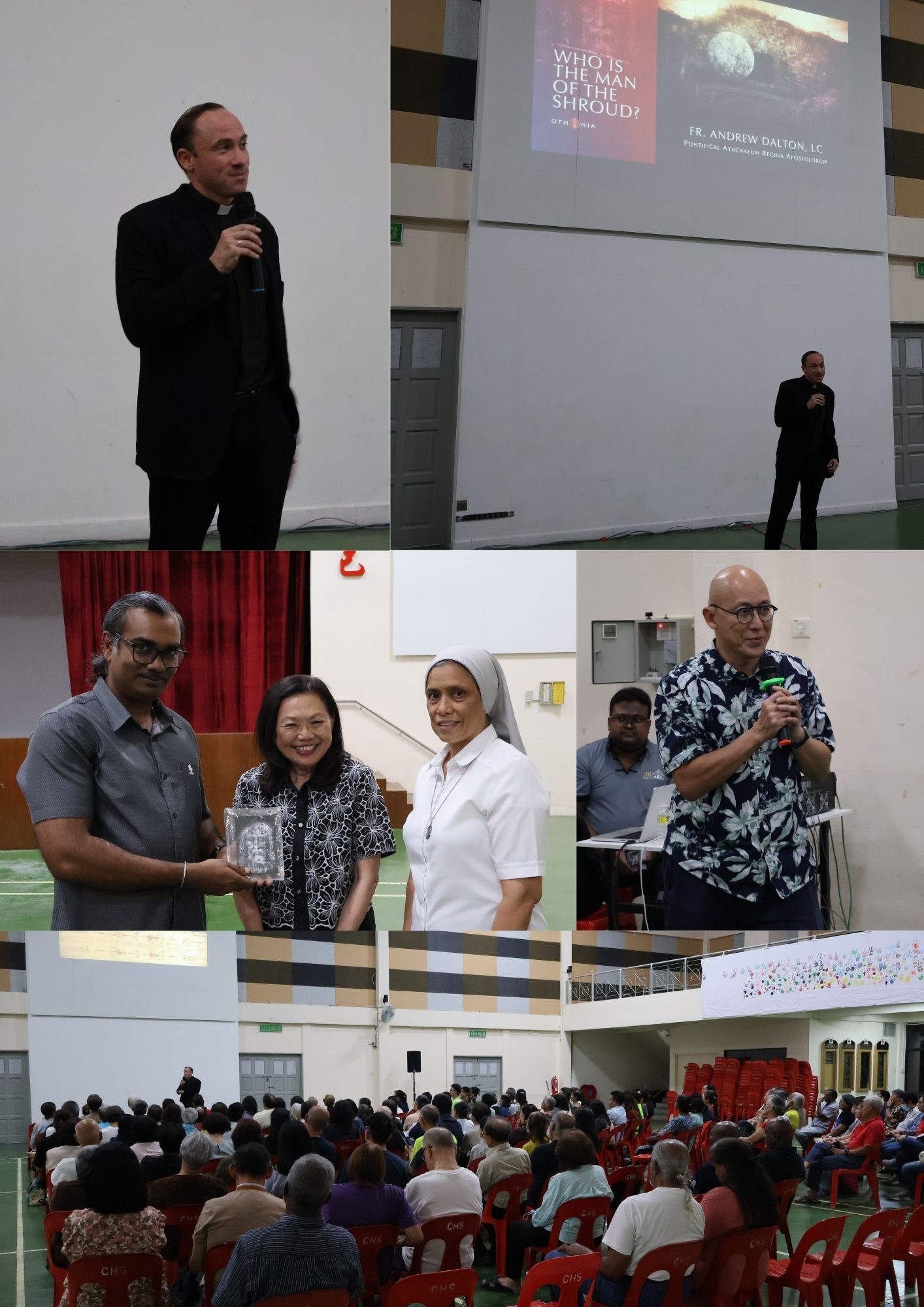On 9th July 2025, as a Jubilee Year Initiative in collaboration with Othonia Foundation, Rome, approximately 350 People of God in Penang gathered at the Cathedral of the Holy Spirit, Penang, Malaysia to delve into the mysteries of the Shroud of Turin. Pope John Paul II said that the Shroud of Turin is a mirror of the Gospel and “a silent witness” of Christ’s passion, death and resurrection.
Presenting the talk is Rev. Fr. Andrew Dalton, a Catholic priest of the Legionaries of Christ (LC) and Professor of Theology at the Pontifical Athenaeum Regina Apostolorum, Rome. Fr. Dalton teaches the Synoptic Gospels, Biblical Greek and Hebrew. For the Postgraduate Certificate in Shroud Studies, he lectures on the Biblical Theology of the Passion of Christ. Fr. Dalton is well known internationally in Shroud lectures drawing connections between scientific observation and theological interpretation. The lecture was introduced by Sister Margarete Sta Maria FDCC, Director of Archdiocesan Pastoral Institute (API), and Ms. Joan Foo.
The lecture begins at the Empty Tomb where we witness Peter and John racing towards the burial site. Upon arrival the tomb is found empty with the burial clothes (othonia) lying there and the face cloth (sudarium) is folded and set apart. The emptiness of the tomb and undisturbed collapse of linen clothes with the straps, together with the myrrh and aloes in place, suggest the body had miraculously passed through the cloth. This marks the sign of the Resurrection and as the Gospel attests, “John saw and believed” (‘John 20’).
In 1898 photographer Secondo Pia captured the first image of the Shroud unveiling an astonishing phenomenon - the Shroud behaves like a photographic negative, incomprehensible for a centuries-old relic. Decades later the Shroud of Turin Research Project (STURP) undertook extensive studies and determined the image is not created by paint, artwork, dye, or artistic techniques. The image rests on the surface of the cloth fibres at just 0.2 microns deep (200 nanometres). In 1976, using the NASA VP-8 Image Analyzer, revealed the Shroud encodes 3-Dimensional data. The intensity of the Shroud’s image is directly proportional to the distance between the cloth and body, so areas like nose appear darker. A photograph or painting is flat and does not contain this information.
The bloodstains were confirmed to be real human blood, type AB and contains elevated levels of ‘bilirubin’ a compound released into the blood stream under extreme trauma and torture. The Shroud is large measuring 4.4 x 1.1 metres with a costly 3 over 1 herringbone pattern, and we think Joseph of Arimathea. Furthermore, the analysis of dirt particles on the knee and feet revealed travertine aragonite, a rare type of limestone matching the soil from ancient tombs of Jerusalem affirming geographical authenticity. The Shroud shows no sign of decomposition, or blood smearing.
Current peer reviews on the 1988 radiocarbon-dating report, shows that it was flawed due to possible bacteria contamination, colonizing textile fibre, and data flaws. Note: Author William West ‘The Shroud Rises as the Carbon Date is Buried” will attest to this. In 2019, a team of scientists from the Institute of Crystallography in Bari led by Dr. Liberato De Caro performed research using Wide-Angle X-Ray (WAXS) scattering as way of measuring the age of linen threads and now date the Turin Shroud to the time of Jesus. Physicist Paolo di Lazzaro in 2011, says the image is characteristic of intense, instantaneous burst of ultraviolet radiation exceeding the capacity of modern technology. It would require “pulses having durations shorter than one forty-billionth of a second and intensities on the order of several billion watts” For believers, the radiation thesis suggests that a “divine light” in the tomb might have seared the crucified form of Jesus Christ onto the shroud.
Fr. Daltons final convergence of faith and science brought the People of God to a place of reverence. He drew connections between Gospel events and forensic evidence in the Shroud. Fr. Dalton believes that the Shroud in the tomb once bore the crucified body of Christ, but the Altar today holds the living, risen and glorified Christ.
Jesus sweating blood (hematidrosis) in Gethsemane causes intense pain to the skin and Judas kiss would have registered great pain. The Shroud reveals a deflected nasal cartilage and severe swelling in the cheeks consistent with the blows received at the Sanhedrin. The dorsal image records 360 scourge wounds from a flagrum whip, with lead-tipped thongs, done by the 2 Roman soldiers. The scalp wounds indicate the crown of thorns was not merely a circlet but more likely a hastily constructed cap of thorns covering the whole scalp. The wrist wound shows that the nail pierced through the Destot’s space in the wrist. The lance pierced between the fifth and sixth ribs produced stains containing both post-mortem blood and clear serum (“the water”), a telltale sign of pleural effusion- fluid buildup from severe physical distress.
The talk concluded with a beautiful song “God’s Face’ by Rev. Fr. Stephen Howe LC, and a prayer with discernment to “I have sought your face with all my heart; be gracious to me according to your promise,” (Psalm 119:58).
I CAME, I HEARD, AND MY FAITH STRENGTHENED!
By Christopher Kushi

